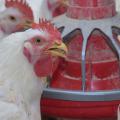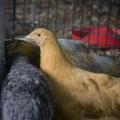General characteristics of Disinfectants
ALCOHOLS (Isopropyl or Ethyl Alcohol)
- Wide germicidal activity, non corrosive, but poses a fire hazard.
- Limited residual activity due to evaporation.
- Alcohols provide limited activity in the presence of organic matter.
- Not considered effective against bacterial or fungal spores.
- Excellent for disinfecting instruments or other small objects.
- Too expensive for general use in the hatchery.
- Must use as a 70-95% concentration for effectiveness.
HALOGENS (Iodines or hypochlorites)
- Provide wide germicidal activity but are corrosive.
- Limited activity when in the presence of organic matter.
- Poor residual activity, low toxicity, but may stain surfaces.
- Not effective as sporocidal agents.
- Effective at low concentrations for disinfecting clean, small objects.
- Low cost but requires frequent applications.
QUATERNARY AMMONIUM COMPOUNDS
- Limited germicidal range.
- Not sporocidal, effective against vegetative bacteria, fungi and viruses.
- Reduced efficiency in the presence of organic matter.
- Limited effectiveness in soaps, detergents and hard water salts.
- Non-irritating, non-corrosive and low toxicity.
- Residual activity is limited by the amount of recontamination.
- Good disinfectant for use on cleaned surfaces.
- Low cost.
PHENOLICS (Single or Multiple)
- Wide germicidal range, not sporocidal.
- Low toxicity and low corrosiveness.
- Very effective in the presence of organic matter.
- Good residual activity and deodorizer.
- Low to moderate cost.
COAL TAR DISTILLATES ( Cresol and Cresylic Acid)
- Wide germicidal activity, not sporocidal.
- Corrosive and toxic at high concentrations.
- Excellent residual activity with heavy odor.
- Highly efficient in presence of organic matter.
- Not well suited for use near eggs or chicks due to noxious gases.
- Moderately expensive.
ALDEHYDES (Glutaraldehyde)
- Wide germicidal activity, sporocidal and fungicidal.
- Slight to moderate efficiency in presence of organic matter.
- Slight residual activity.
- Moderately toxic.
- Moderate cost.
OXIDIZING AGENTS (Hydrogen peroxide, Potassium Permanganate)
- Moderate to wide germicidal activity, not sporocidal.
- Rendered ineffective in the presence of organic matter.
- Moderately corrosive, limited toxicity.
- Poor to limited residual activity.
- More valuable as a cleansing and deodorizing agent.
- Moderate cost.
Publications
News
STARKVILLE, Miss. -- Until an avian flu vaccine for chickens or other alternative is federally approved, commercial poultry operations in the U.S.
STARKVILLE, Miss. -- If egg prices have seemed higher than ever lately, it’s because they are, and consumers can place much of the blame squarely at the feet of the ongoing bird flu outbreak.
With highly pathogenic avian influenza, or HPAI, in the environment in Mississippi, owners of backyard flocks have to take extra steps to keep their chickens healthy.
Avian influenza poses an extremely low risk to human health and none to food safety in Mississippi, but its presence poses a risk to backyard flocks and the state’s $3 billion commercial poultry industry.







